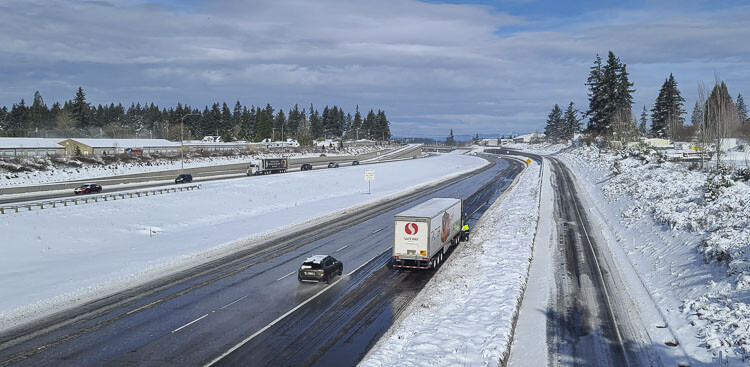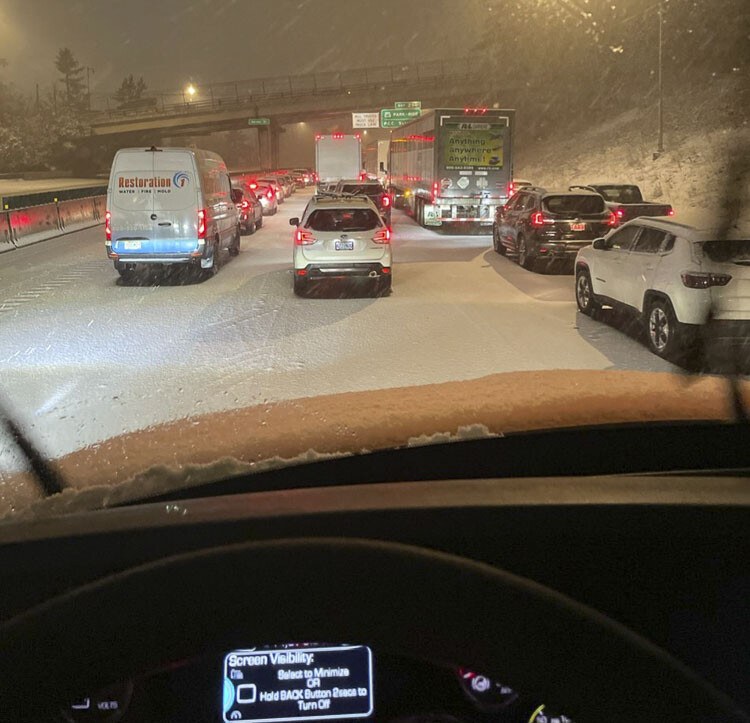
Vancouver truck driver said it took him nine hours to go about 13 miles
Paul Valencia
ClarkCountyToday.com
At first it was going to be one dusting of snow in the morning, a few showers maybe, and then a bigger wave of snow after sunset on Wednesday.
Well, that was the forecast anyway.
Only, the snow never stopped.
Call it the old-school Energizer Bunny Storm, if you want.
Because it just kept going, and going and going.
The only things that weren’t going and going were vehicles on Portland-area freeways as some were stranded for hours. That would include Clark County motorists such as Scott Tianen, a truck driver who lives in Vancouver but works in Oregon. He is home on a typical day at 6 p.m. He did not get home until 4:30 a.m. Thursday.

Those initial snow showers on Wednesday morning never subsided, and snow fell in the region throughout the afternoon and well into the evening hours.
In fact, Wednesday’s snow event was one of the biggest one-day snowstorms in the region’s history.
This was all followed by an arctic blast of air as temperatures plunged into the low 20s or colder in Southwest Washington.
Precipitation on Wednesday night and into Thursday morning froze on the roadways.
Just about every government agency — schools, city, and county offices — closed Thursday. Many private businesses asked their employees to work from home.
As of 9:30 a.m., blue sky appeared over Vancouver with partly cloudy conditions. Forecasters expect the snow storm to be over, but it will remain bitterly cold.
“There will be no major warm-up this afternoon,” warned the forecast on KATU.com. “Conditions will only improve slightly.”
Forecasters expect Thursday night will bring the coldest temperatures of the winter, with much of the region dropping into the teens. That leaves the possibility of roads being too treacherous for school buses to operate Friday morning. Parents should plan for the possibility of a two-hour delay or another full day of cancellation.
Portland measured the second-most snowfall in a calendar day in recorded history with 10.8 inches. The most was 14.4 inches on Jan. 21, 1943, according to the Portland office of the National Weather Service. The 10.8-mark is the most for a February storm.
Around Southwest Washington, some areas of Washougal had 16 inches of snow, according to the NWS. Some areas in Camas had 14 inches. The totals varied throughout the region.
Those at home watching local news witnessed the commute from hell on Oregon’s roads on Wednesday night.
Scott Tianen experienced it.
“Everything was fine,” he said of his trip to Grants Pass, and then the trip back north to his terminal in Northwest Portland.
Well, fine until he got to the Portland area.
“Funny how Grants Pass and Roseburg and Eugene and Salem can manage their freeways just fine. When it comes to Portland, it’s a nightmare,” Tianen said.
He was northbound I-5 near the Terwilliger Curves when everything stopped.
“It was abandoned vehicle after abandoned vehicle. That causes such a problem,” Tianen said.
Semi Trucks have to weave around those vehicles, causing them to slow. It becomes a chain reaction, going from slowdown to shutdown.
From there, it took seven hours for Tianen and his truck to get to I-405. Then another two hours to get to the terminal in Northwest Portland so he could get in his personal vehicle and come home to Vancouver.
“That entire time I did not see one snow plow, one gravel truck,” Tianen said. “Not one drove past us for nine hours. I just find that surprising.”
A longtime truck driver, he has been in delays that have lasted for a few hours.
“You just roll with it,” he said.
Wednesday night/Thursday morning, though … just different.
“Last night I didn’t see an end. I thought I was going to be in that truck forever,” he said.
The truck was on fumes by the end of the trip. He remained on the road because if he had pulled over to wait it out, his truck would have lost heat once it ran out of gas.
Tianen and other professional drivers get frustrated with those who are not prepared for winter driving.
“This is the Pacific Northwest. We’re not new to snow. It’s not like snow doesn’t happen,” he said. “To not have chains or an emergency roadside kit in your trunk is just irresponsible. Being unprepared is just irresponsible. A set of chains can stop a lot of problems.”
He noted that most tire stores will teach drivers how to put on chains. And even those who don’t know how, others would be willing to help out along the roadside. But the vehicle must have chains first.
Tianen, in fact, helped two drivers put on chains Wednesday night.
He had the time. He wasn’t going anywhere fast.
Also read:
- Supreme Court Commissioner: WA’s high-capacity magazine ban staying in placeState Supreme Court Commissioner Michael Johnston ruled Thursday morning that the buying or selling of high-capacity magazines will remain illegal in Washington while legal challenges against the ban are being decided.
- Opinion: Gov. Inslee’s latest wasteful EV subsidy is the equivalent of paying $1,125 for a latteTodd Myers of the Washington Policy Center says that we can expect Washington’s elected officials to continue to prioritize politics over the planet.
- Basketball coach James Ensley heading home to Battle GroundJames Ensley, who has been the athletic director and head boys basketball coach at Fort Vancouver, is going home to coach at Battle Ground High School, where he graduated from in 1996, after budget cuts eliminated his AD position at Fort Vancouver.
- Ridgefield School District school bond proposal rejected by votersThe first results of the April 23 special election show the school bond proposal in the Ridgefield School District is currently failing approval.
- Opinion: Not guilty verdict appropriate resolution in case of VPD officerClark County Today Editor Ken Vance offers his praise to the jury in the trial of Vancouver Police Officer Andrea Mendoza.
- County selects Christopher Swaby to head up new Public Defense officeDeputy County Manager Amber Emery announced this week that the county has selected long-time public defense attorney Christopher Swaby as the county’s first director of public defense and chief public defender.
- Wil Fuentes announces candidacy for Clark County Council in District 3Wil Fuentes has officially announced his candidacy for Clark County Council in District 3.











